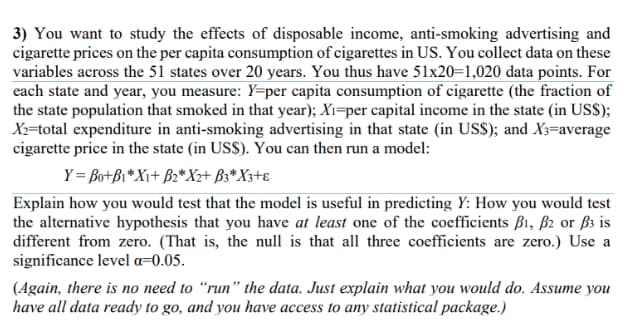3) You want to study the effects of disposable income, anti-smoking advertising and cigarette prices on the per capita consumption of cigarettes in US. You collect data on these variables across the 51 states over 20 years. You thus have 51x20=1,020 data points. For each state and year, you measure: Y=per capita consumption of cigarette (the fraction of the state population that smoked in that year); X1=per capital income in the state (in US$); X2=total expenditure in anti-smoking advertising in that state (in USS); and X3=average cigarette price in the state (in US$). You can then run a model: Y = Bo+Bi*X1+ B2*X+ B3* X3+ɛ Explain how you would test that the model is useful in predicting Y: How you would test the alternative hypothesis that you have at least one of the coefficients B1, B2 or ß3 is different from zero. (That is, the null is that all three coefficients are zero.) Use a significance level a=0.05.
3) You want to study the effects of disposable income, anti-smoking advertising and cigarette prices on the per capita consumption of cigarettes in US. You collect data on these variables across the 51 states over 20 years. You thus have 51x20=1,020 data points. For each state and year, you measure: Y=per capita consumption of cigarette (the fraction of the state population that smoked in that year); X1=per capital income in the state (in US$); X2=total expenditure in anti-smoking advertising in that state (in USS); and X3=average cigarette price in the state (in US$). You can then run a model: Y = Bo+Bi*X1+ B2*X+ B3* X3+ɛ Explain how you would test that the model is useful in predicting Y: How you would test the alternative hypothesis that you have at least one of the coefficients B1, B2 or ß3 is different from zero. (That is, the null is that all three coefficients are zero.) Use a significance level a=0.05.
Principles of Economics 2e
2nd Edition
ISBN:9781947172364
Author:Steven A. Greenlaw; David Shapiro
Publisher:Steven A. Greenlaw; David Shapiro
Chapter1: Welcome To Economics!
Section: Chapter Questions
Problem 26CTQ: Suppose, as an economist, you are asked to analyze an issue unlike anything you have ever done...
Related questions
Question

Transcribed Image Text:3) You want to study the effects of disposable income, anti-smoking advertising and
cigarette prices on the per capita consumption of cigarettes in US. You collect data on these
variables across the 51 states over 20 years. You thus have 51x20=1,020 data points. For
each state and year, you measure: Y=per capita consumption of cigarette (the fraction of
the state population that smoked in that year); Xı=per capital income in the state (in US$);
Xx=total expenditure in anti-smoking advertising in that state (in USS); and X3=average
cigarette price in the state (in US$). You can then run a model:
Y= Bo+Bi*X++ B2*X+ B3*X3+e
Explain how you would test that the model is useful in predicting Y: How you would test
the alternative hypothesis that you have at least one of the coefficients B1, ß2 or ß3 is
different from zero. (That is, the null is that all three coefficients are zero.) Use a
significance level a=0.05.
(Again, there is no need to “run" the data. Just explain what you would do. Assume you
have all data ready to go, and you have access to any statistical package.)
Expert Solution
This question has been solved!
Explore an expertly crafted, step-by-step solution for a thorough understanding of key concepts.
This is a popular solution!
Trending now
This is a popular solution!
Step by step
Solved in 2 steps

Recommended textbooks for you

Principles of Economics 2e
Economics
ISBN:
9781947172364
Author:
Steven A. Greenlaw; David Shapiro
Publisher:
OpenStax

Principles of Economics 2e
Economics
ISBN:
9781947172364
Author:
Steven A. Greenlaw; David Shapiro
Publisher:
OpenStax